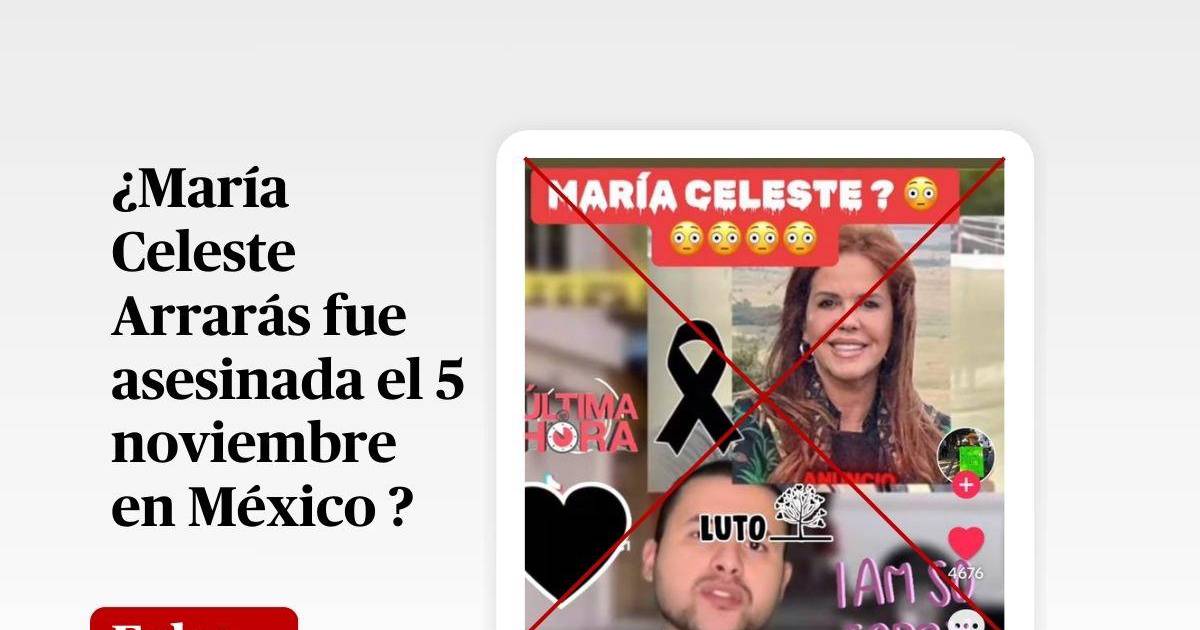Table of Contents
1
Tegucigalpa, Honduras.- A publication circulates on TikTok that states that the journalist and presenter of Puerto Rican origin, María Celeste Arraráswas murdered with a firearm and supposedly died on November 5, 2024, at age 64.
2
But it’s false. The presenter recently published content on her social networks, between November 17 and 22. Furthermore, María Celeste herself came out to deny the rumors of her death.
3
“She was attacked on Wednesday in her food business located in the city of Colima, Colima. The State Attorney General’s Office reported on the attack with a firearm, but they indicate that so far they do not have information that suggests that the crime is linked to their journalistic work,” part of the video that has more than 4,600 likes is mentioned verbatim. and 1,400 shared.
4
The video is accompanied by an image of Arrarás next to a mourning ribbon and with the message verbatim: “Kill journalist Maria Celeste.”
5
María Celeste Arrarás, known for her career in television, especially as host of programs such as Al Rojo Vivo on Telemundo and the newscast Primer Impacto on Univisión.
There is no record of his death
6
A Google search, with the keywords “María Celeste Arrarás+ died” ruled out his death because it did not produce results that prove, with official sources, his death.
7
A review of his personal accounts on the social network Facebook, Instagram and
8
”With my son Julián at the Opera…we loved “The Magic Flute” by Mozart. Here I include some fragments of this great production by @fgopera in Miami,” says a post on Instagram where Arrarás appears with his son.
9
Likewise, he made a post on his Facebook account on November 22, showing frequent activity on his personal accounts.
About the audio
10
In the TikTok publication, the image and voice of the journalist from Noticiero Telemundo in Las Vegas, Benjamín Zamora, who allegedly announced the alleged death of Arrarás appears.
11
When searching on Google with keywords “attacked” + “Colima” + “journalistic work” A post was found on Zamora’s Instagram that has the same audio, but it refers to the murder of the Mexican entertainment journalist Patricia Ramírez González, known as “Paty Bunbury”, on October 31, 2024 and not to the death of María Celeste Arrarás.
Denies rumors
12
In a video published on his social networks, Arrarás denied the rumors of his supposed death.
13
“Last week they killed me twice, once, of course, with leukemia and another supposedly murdered in Mexico, where I haven’t been for several months, so there is no basis, something they only do so that their videos can go viral and perhaps monetize the or for likes”, the presenter published.
14
In conclusion, the television presenter, María Celeste Arrarás, did not die, despite the fact that users on TikTok share it this way.
## Open-Ended Questions for Discussion:
This article presents a case study about misinformation spreading online. Here are some open-ended questions to spark dialog and encourage critical thinking:
**The Spread of Misinformation:**
1. **What motivated the initial spread of the false information about María Celeste Arrarás’ death? What might have been the intent behind it?** (Explore potential motives: seeking attention, malicious intent, accidental sharing without fact-checking)
2. **Why do you think the TikTok post gained so much traction, despite its false nature? What factors contribute to the virality of misinformation online?** (Discuss the role of algorithms, emotional content, lack of media literacy, and trust in sources)
3. **How does the use of real images and audio in fabricated stories contribute to their believability? What strategies can individuals use to identify manipulated content?** (Talk about deepfakes, the importance of verifying sources, and being critical of information encountered online)
**Impact of Misinformation:**
4. **What are the potential consequences of spreading false information about someone’s death? How might it affect the individual, their family, and the public’s trust in reliable sources?** (Discuss reputational damage, emotional distress, erosion of trust in media, and the impact on public discourse)
5. **How can social media platforms and individuals work together to combat the spread of misinformation? What responsibilities do they each have?** (Explore the role of fact-checking initiatives, platform policies, user education, and media literacy programs)
**Maria Celeste Arrarás’ Response:**
6. **How did María Celeste Arrarás respond to the false death reports? What strategies did she use to set the record straight?** (Analyze her public denial, use of social media, and the effectiveness of her response in addressing the situation)
7. **In your opinion, what lessons can be learned from this incident about the importance of verifying information and being cautious about what we share online?** (Encourage reflection on personal responsibility, critical thinking skills, and the need for media literacy in the digital age)
**Thematic Sections:**
Divide the interview into the following sections to guide the discussion:
1. **The Spread of a False Narrative:** focusing on the origin, content, and virality of the TikTok post.
2. **The Impact of Misinformation:** exploring the potential consequences for individuals and society.
3. **Responding to Misinformation:** examining Maria Celeste Arrarás’ actions and strategies.
4. **Combating Misinformation:** discussing potential solutions and shared responsibility.
By using these open-ended questions and thematic sections, participants can engage in a thoughtful and insightful conversation about the challenges and responsibilities associated with navigating the digital landscape in the
age of misinformation.


